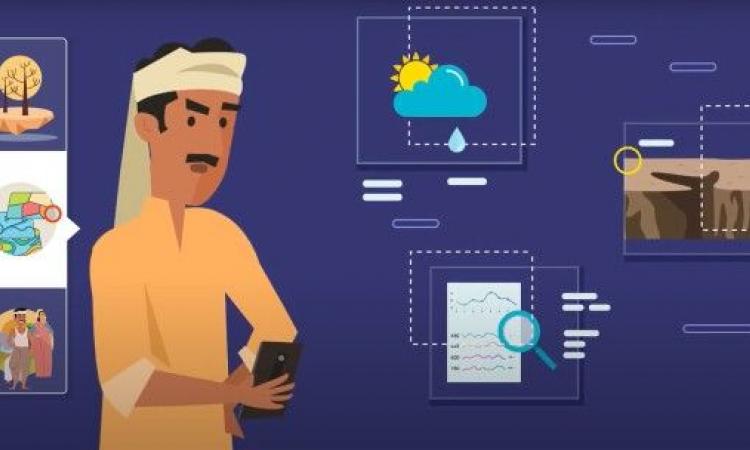
A new digital tool combining scientific climate risk information with local and traditional knowledge is helping communities in India manage climate risks more effectively.
The Mahatma Gandhi National Rural Employment Guarantee Scheme (MGNREGS) is the world’s largest public works-based social protection scheme. While evidence shows that MGNREGS is going some way to help communities in India cope with climate impacts, if the scheme integrates climate risk information in its planning, implementation and monitoring, it has the potential to increase communities’ resilience to climate change by taking early action to address climate impacts.
IIED and the Madhya Pradesh Council of Science and Technology (MPSCT) have co-developed the Climate Resilience Information System and Planning tool for MGNREGS (CRISP-M). The mobile and web-based tool was launched in October by India’s minister for rural development Shri Giriraj Singh, and the UK’s Foreign, Commonwealth & Development Office minister Lord Tariq Ahmad.
CRISP-M has already been successfully piloted in 18 village panchayats of Niwali Block in Badwani, Madhya Pradesh and has been endorsed by India’s rural development ministry with planned roll-out in two districts and seven states.
How does CRISP-M work?
The tool is designed to facilitate climate risk-informed geographic information system (GIS) planning, decision making and monitoring for MGNREGS through three core components:
- Drought early warning system: This feature establishes thresholds that declare drought in the initial stages based on real-time climate data and remote sensing data. This enables decision-makers to initiate drought declaration processes and planning measures for 50 additional days of labour work.
- GIS-assisted asset planning: This feature enables long term decision making by integrating ten layers of GIS along with historical and projected climate data. This feature is accessible to local communities via an easy-to-use mobile app. Communities can modify and update plans – such as which water conservation or harvesting structures to create − based on their local and traditional knowledge.
- Community-based planning and monitoring: This feature allows the community to access data on MGNREGS natural resource management assets, such as where the assets are, and who is benefiting. This feature empowers communities by enabling them to monitor progress.
Using the tool, communities can turn their needs and priorities into collective action. CRISP-M thus seamlessly uses a bottom-up approach alongside traditional top-down approaches to achieve its objective.
Community participation is key
The impacts of climate change and the capacity of local communities to adapt in the aftermath of these impacts is location-specific and also depends on the ability and willingness of the community to adapt – this means communities being fully aware of their vulnerability to climate impacts.
Therefore, community participation is a key facet when developing any tool aimed at building the capacity of communities to better respond to climate impacts.
Drawing on community input and feedback, CRISP-M has been designed to put hands-on community participation front and centre. By ensuring community participation and buy-in, the tool makes communities aware of all the various options available to them during various planning stages, such as during the construction of a check dam or dyke.
COP26 and early warning early action
Despite the escalation of climate change over the past 50 years with impacts that are intensifying rapidly, the UNFCCC did not recognise the importance of early warning systems until the adoption of the Cancun Adaptation Framework in 2010. COP26 in Glasgow saw a strong call for more planning and finance for early warning systems, with the major thrust being behind risk-informed early action.
The following are key requirements for implementing risk-informed early action:
- Availability of reliable early warning systems (EWS): these systems are a prerequisite for providing early warning to governments and communities of impending and ever-changing weather changes that lead to damaging climatic events.
- Initiating early action based on EWS: based on analysis and subsequent early warning of impending disasters predicted by EWS, early action can be initiated to mitigate the consequences. This would provide an ‘early mover’ advantage that could help minimise damage to lives and property.
Easy to use, ready for roll-out
The advantages of combining scientific climate risk information, methods, practices and technology with the community-level planning process, traditional knowledge, practices and skills cannot be overemphasised.
The CRISP-M tool integrates all these elements in a simple, easy to use interface. It can be used not only by organisations but by local communities themselves to prepare in advance for tackling extreme climatic events, especially ‘slow onset’ events such as droughts.
About the author
Raashee Abhilashi is the national coordinator for IIED’s 'Enhancing climate resilience impacts of India’s social protection' programme'
Ally Renton is a former senior coordinator in IIED’s Climate Change research group
The article was first published as an IIED blog here
It has been republished under the CC BY 4.0 license.